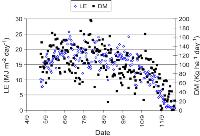Abstract: Water and nitrogen (N) use efficiencies remain generally low in corn production systems. As a result, much of the excess N applied to these ecosystems is leached to ground water and/or emitted to the atmosphere in the form of reactive N gases such as nitrous oxide (N2O) and NOx. The traditional static chamber technique is the standard method for point measuring of trace gas emissions in small scale field experiments, but the spatial and temporal variability make this method time consuming and labor intensive for large field scale experiments. Only recently a fast response N2O sensor became available that makes it possible to use Eddy Covariance (EC) technique for continuous dynamic measurements of N2O flux from large scale fields. In this study, we used the EC technique to measure N2O, CO2 and H2O fluxes in a commercial cornfield in Nolensville, Tennessee that provided the field-scale accurate high frequency (seconds, minutes, or hours) results. We also used the traditional static chamber approach to ground verify N2O emissions in the field. The results indicated that the EC measurements were reasonable compared with the corresponding chamber measurements.
Abstract: Plant water use efficiency (WUE) is defined as the net dry matter production (DM) per unit of consumptive water use. It is a vital variable for plant growth, yield, and irrigation-management models. Pecan [Carya illinoinensis (Wangenh.) C. Koch] WUE has been estimated for above ground biomass growth using evapotranspiration (ET) and DM data measured separately in different experiments. The WUE for whole pecan trees (including above and below ground parts), a direct measurement (ET and DMmeasured in one experiment), and a simple model forWUE based on weather conditions, are currently lacking.A 16.5mwalk-up tower in a flood irrigated pecan orchard, located in the Mesilla Valley of NM, was instrumented with energy budget and eddy flux sensors. Continuous, above canopy measurements of vertical fluxes of sensible heat, H2O vapor, and CO2 were made by the eddy covariance technique in growing seasons from 2002 to 2005. ET was calculated from vapor flux. DM production was calculated from CO2 flux assuming that dry matter of pecan trees was 46.4% carbon. During the growing seasons (May through November), the mean ET was 122.7 cm (48 inch) per season; the mean dry matter production for the whole trees was 22082.3 kg ha⁻¹ (19684.4 lb acre⁻¹) per season. The average seasonal water use efficiency for the whole trees was 179.7 kg ha⁻¹ cm⁻¹ (406.5 lbs acre⁻¹ inch⁻¹). In ‘on’ years (high-yield years) 13.8% of the dry matter produced was allocated to the harvested nut crop, while in ‘off’ years only 8.0% was so allocated. Similarly, the nut WUE as nut yield per unit water used (as cm depth) was higher in ‘on’ years, at 26.2 kg nuts ha⁻¹ cm⁻¹ versus 14.9 kg nuts ha⁻¹ cm⁻¹. A simple model for monthly WUE (kg ha⁻¹ cm⁻¹) as a function of vapor pressure deficit (VPD) and relative humidity (RH) was obtained. It is anticipated that the measured WUE, the simple WUE model, and other data obtained in this study will be useful in developing and validating pecan growth, yield, and irrigation-management models.

The experimental site

Seasonal N2O flux variation (30-minute data).

Eddy-covariance instrument tower in the pecan orchard in January 2003.

Typical daily values of latent heat flux (LE) and dry matter (DM) production of pecan trees in 2002 growing season.